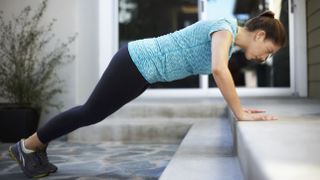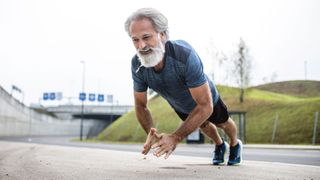What muscles do push ups work?
We asked a physiotherapist: what muscles do push ups work?

What muscles do push ups work? The classic strength-training exercise recruits lots of different muscles for movement and stabilization, but it mainly targets your chest, shoulders and upper arms.
“The muscles that provide the majority of movement during a push-up are the pectoralis major (the largest of the chest muscles),” says physiotherapist Matt Bushell of KC Health Services. “Secondary muscles that assist the movement are the anterior deltoid (front of the shoulder) and the triceps (back of your upper arm).
“Combined, they help to bring your upper arm forward and across your body and straighten your elbow as you push away from the floor. Other muscles involved in creating stability to perform the push up action include the abdominals, quads, and hip flexors as well as lots of little muscles around your shoulders and upper back”.

Matt Bushell is a physiotherapist and exercise scientist with a Bachelor's degree in Sport and Exercise Science from the University of the Sunshine Coast and a Master of Physiotherapy Studies from the University of Queensland. He has spent over 15 years in health, rehabilitation, and performance. He currently acts as principal physiotherapist in his Brisbane practice KC Health Services, spends the odd weekend as a physiotherapist for Football Australia and works in strength and conditioning with high level athletes.
Simple bodyweight exercises like push-ups can help you get stronger without equipment. If you want more resistance for your workout, you could invest in some of the best adjustable dumbbells – but research suggests that bodyweight exercises are sufficient if you want to build strength.
One small study, published in the Journal of Exercise Science and Fitness, showed that a low-load bench press and a push-up could induce similar muscle hypertrophy over eight weeks. So you can expect to see some gains if you stick to the right routine. With that in mind, here are the muscles you'll target every time you do a push-up.
Pectoralis major and minor
These muscles are located in the chest and they are often referred to as ‘pecs’. They play an essential role during push-up as they allow you to move your arm in front of your body, but they also allow your chest and ribs to raise and lower.
Anterior deltoid
The anterior deltoids are muscles on top of your shoulders. They are located over your upper arms and shoulder, along with your rotator cuff. These large muscles assist in lifting your arms above your head and moving them to the sides.

The anterior deltoids will support your body as you perform your push ups, but injuries can be caused through overuse. Always listen to your body and allow for rest days.
Triceps
Your triceps are the large muscles on the back of your upper arm and they are put to work every time you do a push up. They help your body lower and raise during each repetition. They also allow for the extension of your arm at the elbow – getting their name because this muscle group consists of three different muscle heads, all of which meet at the elbow.
Abdominals
The abdominals, or abs, are a large muscle group below the ribs and above the pelvis on your body’s core. They have many key functions, including stabilizing the body, protecting your internal organs, and helping you move easily.
Push-ups – while largely considered to be an upper body workout – can help to build abdominal strength. As long as your form is correct, the abdominal muscles work to stabilize your core during each push up, keeping your body in alignment and supporting your back.
Quads and glutes
The quads are a large muscle group found in the front of each thigh. While push ups don’t specifically target the quadriceps, or quads, they are still used each time you do a push up to keep your legs stable.
The gluteal muscles, found in the buttocks, are secondary muscle groups and they are not the focus of a push up. Even so, they still play an important role in their execution.
There are three major muscle groups that make up the gluteal muscles: the gluteus maximus, gluteus medius, and gluteus minimus. Squeezing your glute muscles as you perform a push up will help to keep your core strong and hips stable.
Push up variations

If you’ve had enough of the standard push up, there are plenty of variations you can add to your workout routine. You can add a cardio boost with a plyometric push up: lower your body slowly to the ground but then come back up with an explosive movement, aiming to clap your hands together before coming back down.
You can also challenge your push ups by adding an incline – placing your feet on a bench or exercise step and your hands on the floor. This will work your shoulders and chest harder, and also requires abdominal strength to keep your body in alignment.
Do you want an added burn to your glutes and chest muscles? In that case, try a one legged push up, which really tests your balance and strength. To do this, assume the normal push up position, but lift one leg into the air, keeping it straight.
And, if the full body push up is too much, you can always adapt the exercise by dropping to your knees, which reduces the amount of body weight you need to lift off the floor.
This article is not meant to offer medical advice and readers should consult their doctor or healthcare professional before adopting any treatment or exercise regime.
Sign up for the Live Science daily newsletter now
Get the world’s most fascinating discoveries delivered straight to your inbox.
Katie Dundas is an American freelance writer now based in Sydney, Australia, frequently covering topics relating to travel, lifestyle, technology, and the outdoors. When not writing, she’s an avid scuba diver, runner, and traveler—often with Apple, her dog. She’s written for a range of publications including Scott’s Cheap Flights, BBC, TechRadar Pro, and Fodor’s and runs a popular travel blog, The Accidental Australian. She’s also a member of the Australian Society of Travel Writers.

